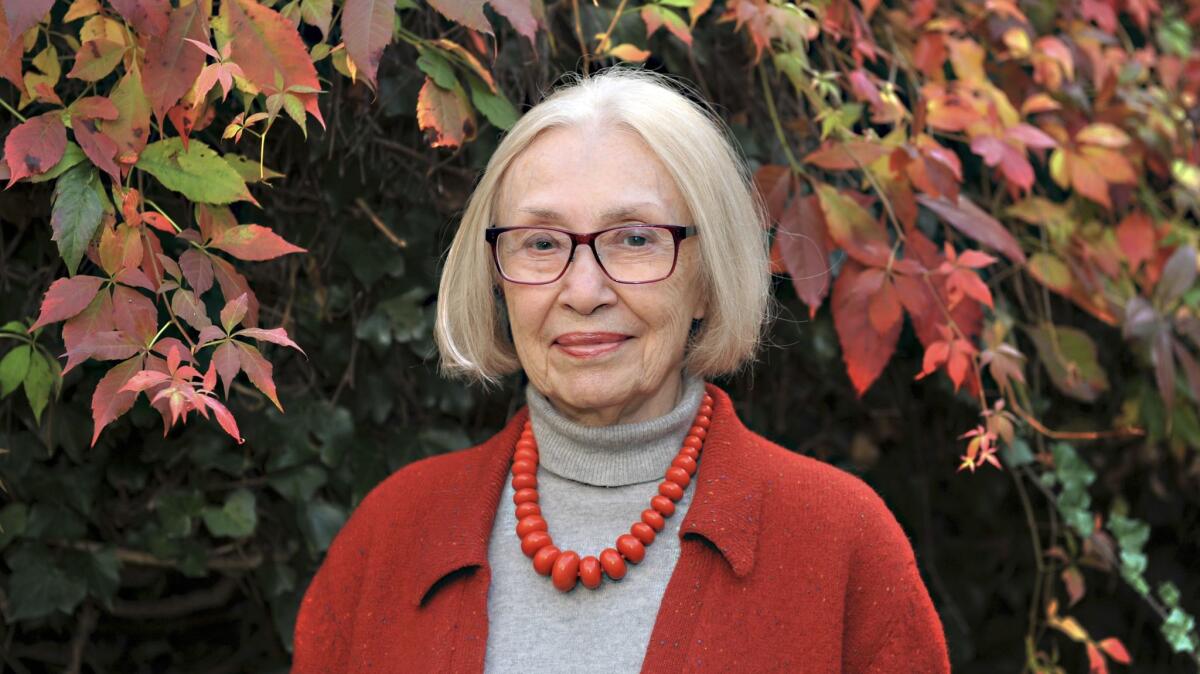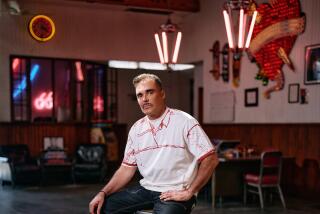How a chance meeting with Einstein led to the accidental start of a unique photography career
- Share via
Reporting from West Sussex, England — In 1948, Marilyn Stafford, a young aspiring actress in New York City, tagged along with two friends who traveled to Princeton to film a documentary about Albert Einstein.
As they pulled up in front of Einstein’s New Jersey home, one of the friends tossed a 35-millimeter camera to Stafford sitting in the rear seat. “Here. You take some stills while we film,” he told her.
Stafford was nervous — she had no experience taking photographs — but Einstein put them at ease.
“He was absolutely lovely,” she recalled. “He met us at the door and there was really no fuss. He was dressed in baggy pants and a sweatshirt. He was completely at ease and made us feel the same. My friends filmed him, he talked and I snapped.”
The result, a series of grainy portraits of the theoretical physicist, was to mark the accidental start of a unique career for Ohio-born Stafford, though she had no idea at the time.
Over the decades, untold numbers of magazine readers would see her photographs, even if they had no idea she was the one behind the lens. Today, at 92, Stafford, a discreet and self-effacing woman, is being drawn out of obscurity because of her extraordinary portfolio that highlights social change in the 20th century, as well of some of her era’s biggest celebrities and world leaders.

The Lucy Bell Gallery, a few miles from her seaside home in West Sussex on Britain’s southern coast, organized an exhibition of her works this year in London; this followed an exhibition at the Alliance Francaise Toronto, a Canadian cultural institute. The Observer, reviewing the London exhibition, said the photographs “depict a century of change, from shifting dress shapes to the impact of world conflicts.”
“They are also proof,” it added, “of the long and varied life of a unique artist.”
The Marilyn Stafford FotoReportage Award was launched on International Women’s Day 2017 to encourage young female photographers.
Lucy Bell, owner of the gallery, said Stafford’s photographs are a time capsule.
“It is all really new material; things have haven’t been properly recorded before, but it’s only now people are beginning to sit up and take notice of her,” she said.
Stafford’s photographs are black and white, but her life could hardly have been more colorful.
Growing up in Cleveland, she was encouraged by her pharmacist father and mother to study drama and was one of the first members of the Cleveland Play House’s children’s group, the Curtain Pullers, along with Joel Grey and Paul Newman.
“It was the era of Shirley Temple — every parent wanted their kid to be Shirley Temple…. We all went to elocution lessons and learned to tap dance,” Stafford said.
“I grew up during the Depression, and from an early age I was aware of the bread lines and the great migrations of people as shown in the photographs of Dorothea Lange, which influenced me tremendously, and the suffering of refugees who’d fled Germany before the Second World War.”
The images of poverty and misery from that time haunted her and influenced her later work. “I wanted to bring attention to people who were suffering,” she said. “I felt that if only people knew about a situation, then something could be done to change it.”
At 23, still hoping to make a name on the stage, Stafford moved to New York but soon afterward traveled to Paris, where in 1949 she joined a cabaret ensemble singing at Chez Carrere, a classy dining club off the Champs-Elysées.
“The French capital was still recovering from the wartime Nazi occupation and full of U.S. expats with more arriving every day. If you had American dollars, which we changed on the black market, it was very cheap living in France at the time,” she said. “Looking back, it was a fantastically exciting time to be young and single.”
At Chez Carrere, Stafford met the wealthy and famous, including Eleanor Roosevelt, Edith Piaf and Charles Aznavour.
“There were Paris nightclubs, and there was Chez Carrere. It was the place to be.”
She also met Bing Crosby.
“He was very ‘correct’ as the French say, but I knew he was fond of me. I was living at the time in a little ground-floor studio with another American girl, and he used to come along every Sunday morning having bought croissants from the local boulangerie. Bing was married, but we became good friends, and we stayed friends for many years,” she said.
Stafford often carried her Rolleiflex camera and took off-the-cuff snaps of her new friends. Many were taken at Piaf’s Parisian home, where the star and her entourage would return for breakfast after a night at Chez Carrere.
“I wasn’t doing it professionally. I wasn’t even thinking as a photographer. I thought Piaf was rather wonderful. She was very down-to-earth. She loved love,” Stafford said.
Stafford eventually had to give up the cabaret job because she lost her voice.
“I think I lost my voice because I really didn’t want to be a singer, but I really didn’t know what I was going to do to earn a living,” she said.
In Paris, Stafford had been introduced to the now-iconic photographers Robert Capa and Henri Cartier-Bresson, founders of the Magnum Photos agency, so she mentioned to Capa that she would like to try her hand at photography. He suggested she work with his Magnum co-founder David Seymour, known as “Chim,” who was working for U.S. magazines, including Life.
“I said no. Both Chim and Capa were working in war zones, and I didn’t want to go to war. As we know, both were later killed in war zones,” she said. (Capa died in Indochina in 1954, Seymour in the Suez war two years later.)
Instead, she went into public relations. During a stint with a fashion company, in the late 1950s, Stafford was asked to take pictures of a new trend: ready-to-wear. Stafford insisted on taking models out of their gilded haute couture houses to be pictured in the streets and boulevards — unheard of at the time.
“I took the models out on the streets, because I love the streets. I didn’t care so much about the clothes, but I loved the streets,” she said.
After marrying British newspaper foreign correspondent Robin Stafford, she turned her lenses on Paris slums and traveled to North Africa to photograph refugees fleeing government repression in Algeria, then a French colony. Her pictures of refugees living in tents pitched in an arid landscape capture their hardships but also their determination and dignity.
“At the heart of it is how I saw the world around me,” she said. “Even when I was taking photographs to earn a living, I saw and felt things that I believed needed to change so intensely and would ask myself, ‘How can I help make it better?’ ”
In the mid-1960s, Stafford and her husband went separate ways — she and their young daughter to London, he to Moscow.
“I was really on my own. I had to earn a living with a young child, so I did whatever I could: PR, photography, news assignments,” she said.
One evening, after accepting a dinner invitation from friends, Stafford found herself dining with actor Lee Marvin.
“We hit it off and struck up a great friendship, a lovely friendship. I remember once we were talking about the film ‘Paint Your Wagon’ and I said I hadn’t seen it, so he took off his boots and sang the whole of ‘Wandering Star’ to me. It was so sweet.”
In 1972, she was commissioned to document Indian Prime Minister Indira Gandhi at home and on tour of India. Stafford was so enamored of India she returned several times for different assignments.
Then the digital age of the 1980s arrived, and Stafford hung up her now-outdated cameras and retired into the shadows of the southern England seaside.
Serving tea and cakes at her pretty terraced home, she seems acutely embarrassed to be talking about herself. Few, if any, of her neighbors know of the extraordinary life and career of the small but elegant woman who now lives alone with her ginger tomcat, Josh.
“I stopped when it all became digital. I do still have my cameras, but I don’t really miss taking pictures. Every once in a while I see something and I think, I really wish I had my camera, but my focus is now on the [FotoReportage] Award,” she said. “It’s possible I might if I had the right project, but I think one needs a fresh eye, a fresh vision.”
She seems genuinely surprised anyone is interested in her and her many boxes of photos. With a shake of her head, she said, “Oh the wonderful memories I have. Life has been good to me.”
Willsher is a special correspondent.
To read this article in Spanish click here
More to Read
Sign up for Essential California
The most important California stories and recommendations in your inbox every morning.
You may occasionally receive promotional content from the Los Angeles Times.










